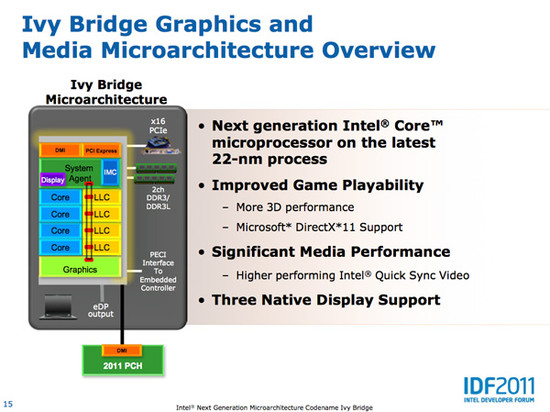In part three of our interview Intel’s Pat Bliemer, Managing Director Intel Northern Europe, we move away from manufacturing technology and smartphones to more traditional topics. You can really tell that AMD has made a great job with Llano when you talk to manufacturers, but also the weight of integrated graphics came up.
Ever since Intel gave up on the Netburst architecture and instead transition to Conroe – Core 2 the company has been on a hot streak. AMD has tried to fight back with performance/price products, but Llano became the product it was searching for and needed for so long. The circuit has relatively good energy consumption and class leading graphics circuit when compared to other integrated circuits. Llano did not bring any real news in the processor department, but was sufficient to make the manufacturers flock around the new platform. Our question to Pat Bliemer was if it sees AMD gaining in any segment thanks to Llano, and in the lower segment he did see that more products was powered by Llano, but also Brazos, but all is just a matter of price. He doesn’t think AMD is very pleased with the situation it is in.
“AMD is and will always be a serious competitor of ours. I do think that based on where we started this discussion, particularly on the manufacturing side and the lead that we have with architecture and manufacturing that it has been alot harder to them to compete effectively against us. So therefor most of it is price driven, so I would say if there’s an area – we have to always continue to make sure we will remain competitive in the low end of notebooks right now, which is largely fueled by their Llano and Brazos products that actually go into that segment. So it’s a pricing game but I think that from a performance and experience point of view it is not much for them right now to really pleased about I think. But they will always stay competitive.”
When we discussed graphics we asked if Intel had any hopes to catch up to Llano with Ivy Bridge that is next in line, and where the focus on the graphics front really is. he says that modern solutions are more than good enough for most users, but the problem is how people perceive integrated graphics. Just a few years ago there was no integrated graphics worth mentioning, today is totally different story.
 The hard part is to convince consumers that integrated solutions are sufficient
The hard part is to convince consumers that integrated solutions are sufficient
“I would say that the biggest thing that we’re up against is perception. And it’s not as much as actual performance or that ours is not as good as theirs or vice versa. I do think that there still is a notion with a average computer user that you need to have a discrete graphics solution and that integrated graphics is not as competitive. And I think this applies as much to AMD as it does to us right?”
We said that he may be right – the problem is how integrated graphics is perceived by consumers that are stuck in old ways of thinkinh and that many have a hard time believing that Llano offers a gaming experience. He could not help admitting that Llano offers good graphics performance (but also points out that it is a lot better than AMD’s processor performance), he continues with saying that current integrated solutions are good enough for many games with acceptable frames per second.
“Yeah and if there’s something, actually the graphics performance of Llano is alot better then their CPU performance. So actually again, it’s the perception that works against both and the way the market evolved and people are always looking at that and they believe that if you only have integrated graphics that you cannot play all the games that you want to play, that you cannot run the resolutions on your monitor and things that you do with the framerates – but actually that’s a myth.[…]At the other hand, I would say our graphics performance is going to continue to increase.”
Last we asked what goals Intel had set up with its integrated graphics. Is it aiming for being capable of playing material in HD, a solution for gamers or accelerating applications? It looks like Intel is looking to deliver something that will be sufficient for most, and therefore has no exact goals set up, but it all comes down to what the market wants.
 The graphics of the future will be sufficient for most – Source: Anandtech
The graphics of the future will be sufficient for most – Source: Anandtech
“The future goal is certainly not that we have a vision or so that in a few years time there’s not going to be any external graphics solutions available any longer. We do not think that 100 percent of the market is going to go integrated. We do think that more people will realize that they, what actually they have in their default is good enough to run 99,98 percent of the things that they do. If you talk about mainstream gaming you can elegantly do it already based on GT2 [Intel HD 3000] solutions that we have. If you want to go do something like some of the real serious games that these guys are playing here behind us [at Dreamhack], then you have the need for external graphics.”
We will publish more from the hour-long interview with Pat Bliemer in the coming days, so keep an eye for more on Ultrabooks but also Intel’s vision for future processors that include much more than we imagined.



















